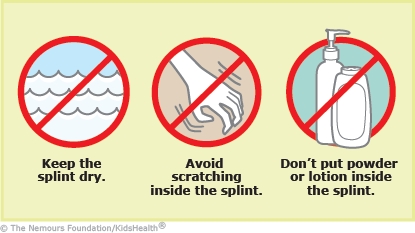Help your child wear the splint as instructed and care for it so it stays in good condition.

General splint care:
- Follow your orthopedic specialist's directions on whether you can adjust the splint and whether your child can take it off to bathe and sleep.
- To help prevent swelling in the first few days after the splint is put on:
- Have your child raise the splint above the level of their heart for about 20 minutes 3–4 times a day.
- Have your child wiggle their fingers and toes throughout the day.
- Keep food, dirt, sand, lotion, and powder away from the splint.
- If given a sling or crutches, your child should use them as directed.
Problems to watch for:
- Swelling: If the fingers or toes get swollen, have your child raise them above heart level for up to an hour.
- Sharp splint edges: If the skin near or under the splint gets red or irritated, put moleskin (available at drugstores) on the edge of the splint.
- Itching: Don't let your child scratch or put anything under the splint for itching. Instead, tap lightly on the splint or use a hair dryer on the cool setting to blow air in and around the edges.
Be sure to:
- Follow up with the orthopedic specialist as recommended.
- Ask the orthopedic specialist if your child needs to avoid gym, sports, or any other activities.
If Your Child Has a Splint That Can't Be Taken Off
Keep the splint dry:
- No swimming, even with a plastic cover over the splint.
- Avoid getting the splint wet during bathing. Give younger kids sponge baths. To give a sponge bath, use a wet sponge or washcloth to wash and rinse your child.
- Older kids can take baths. They need to cover the splint and keep it out of the water by propping it up on the side of the tub. There are several ways to cover the splint while bathing. You can:
- Cover it with two plastic bags. First, put one bag on and seal the top with a rubber band (or tape). Then, put the second bag on and seal it with another rubber band (or tape).
- Cover it with 1–2 layers of plastic wrap and then a plastic bag that is sealed at the top with a rubber band (or tape).
- Use a waterproof plastic splint/cast protector. You can buy these online or at most drugstores without a prescription.
If the splint gets splashed, gently blow air into it from a hair dryer on the cool or fan-only setting.

What do splints do? Splints hold bones and joints in place so they can heal after a broken bone, injury, or surgery. Splints also can help with other conditions that affect the joints (such as arthritis) or muscles (such as palsies, which are weakness or paralysis of a muscle).
When would a splint be used instead of a cast? If the area is swollen, a splint can be better than a cast because a splint can be loosened, if needed. When the swelling goes down, the health care provider might put on a cast while the injury heals.



